Identification of the Problem Behaviour
VerifiedAdded on 2022/08/20
|9
|2265
|13
AI Summary
Contribute Materials
Your contribution can guide someone’s learning journey. Share your
documents today.
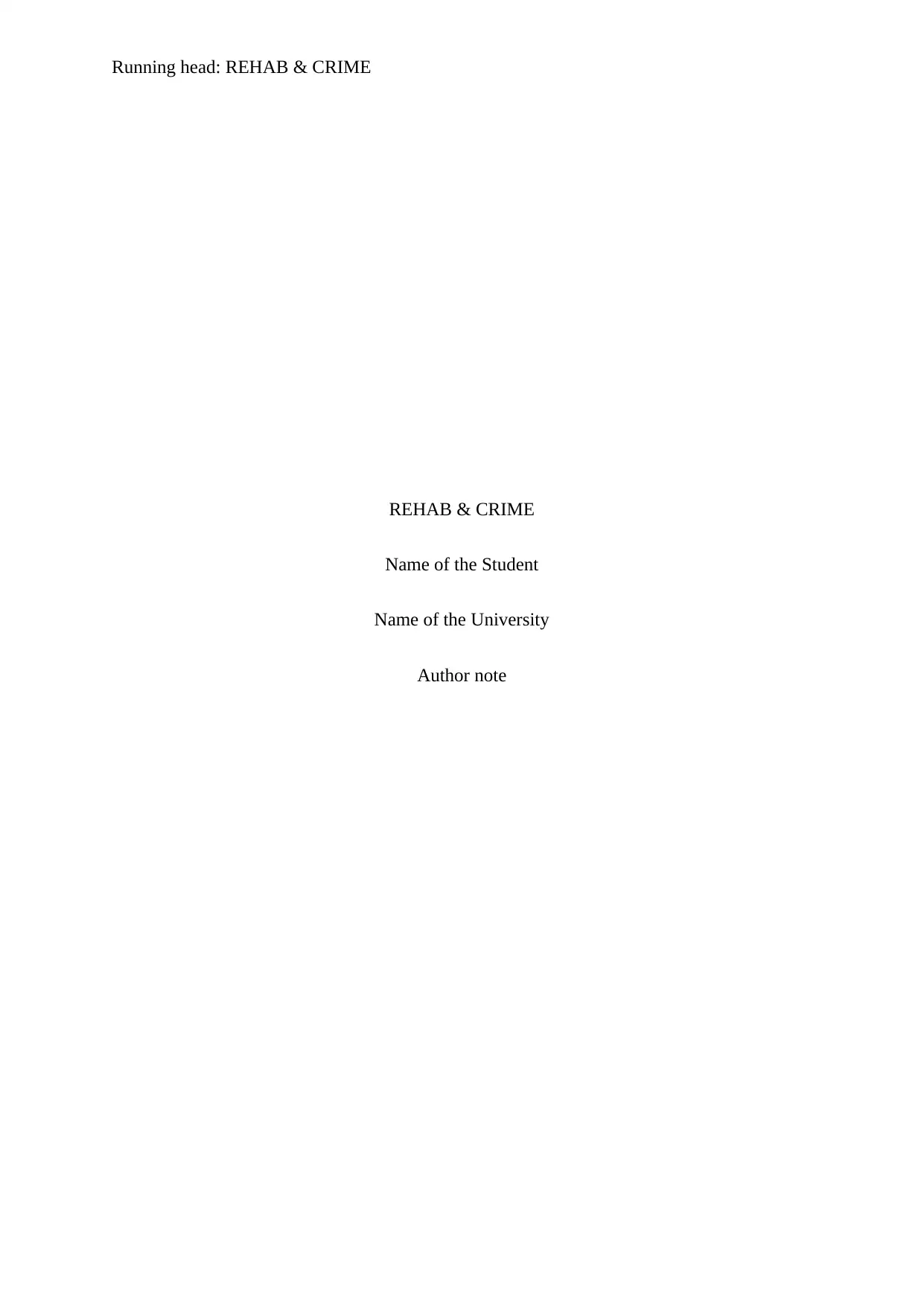
Running head: REHAB & CRIME
REHAB & CRIME
Name of the Student
Name of the University
Author note
REHAB & CRIME
Name of the Student
Name of the University
Author note
Secure Best Marks with AI Grader
Need help grading? Try our AI Grader for instant feedback on your assignments.
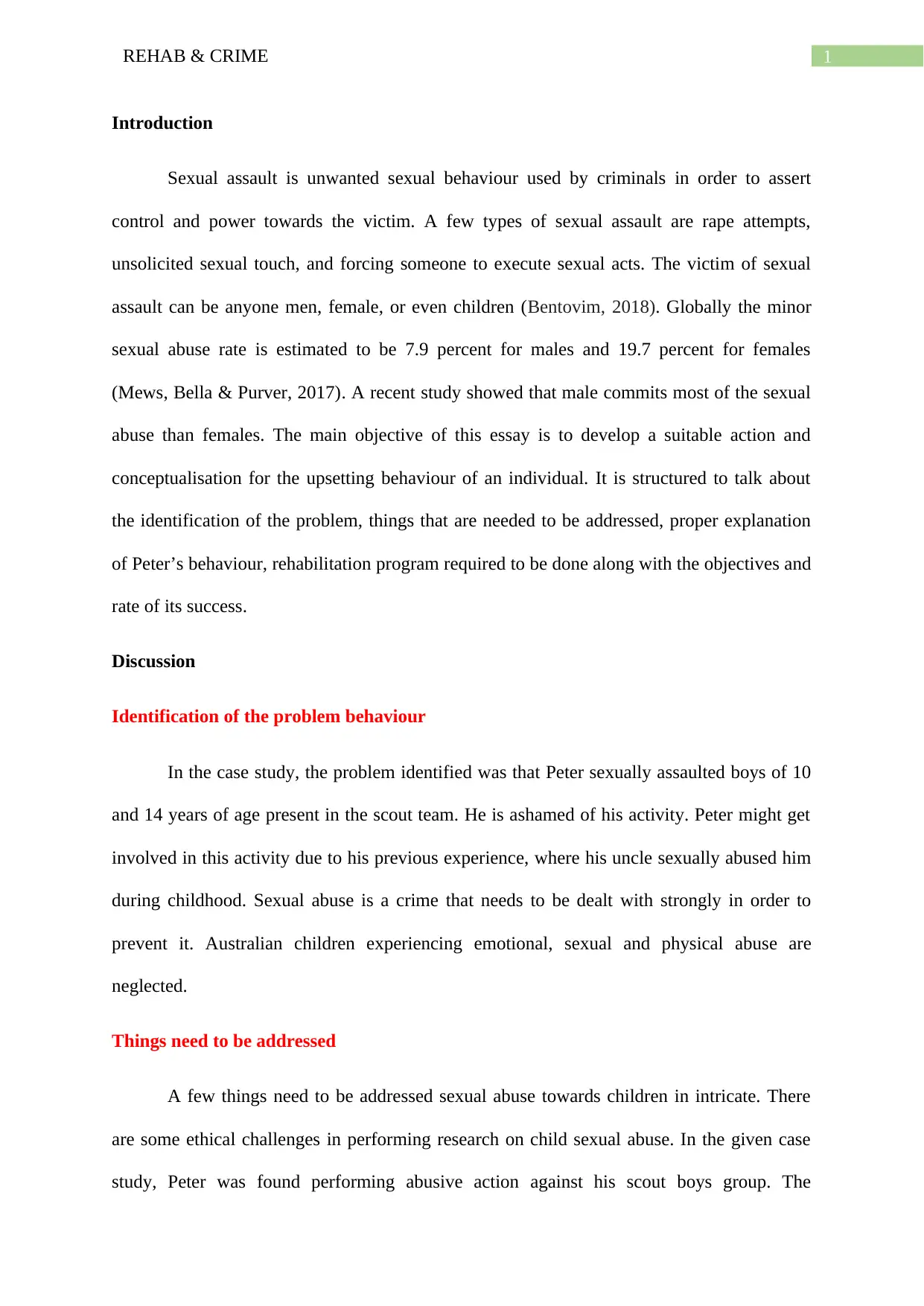
1REHAB & CRIME
Introduction
Sexual assault is unwanted sexual behaviour used by criminals in order to assert
control and power towards the victim. A few types of sexual assault are rape attempts,
unsolicited sexual touch, and forcing someone to execute sexual acts. The victim of sexual
assault can be anyone men, female, or even children (Bentovim, 2018). Globally the minor
sexual abuse rate is estimated to be 7.9 percent for males and 19.7 percent for females
(Mews, Bella & Purver, 2017). A recent study showed that male commits most of the sexual
abuse than females. The main objective of this essay is to develop a suitable action and
conceptualisation for the upsetting behaviour of an individual. It is structured to talk about
the identification of the problem, things that are needed to be addressed, proper explanation
of Peter’s behaviour, rehabilitation program required to be done along with the objectives and
rate of its success.
Discussion
Identification of the problem behaviour
In the case study, the problem identified was that Peter sexually assaulted boys of 10
and 14 years of age present in the scout team. He is ashamed of his activity. Peter might get
involved in this activity due to his previous experience, where his uncle sexually abused him
during childhood. Sexual abuse is a crime that needs to be dealt with strongly in order to
prevent it. Australian children experiencing emotional, sexual and physical abuse are
neglected.
Things need to be addressed
A few things need to be addressed sexual abuse towards children in intricate. There
are some ethical challenges in performing research on child sexual abuse. In the given case
study, Peter was found performing abusive action against his scout boys group. The
Introduction
Sexual assault is unwanted sexual behaviour used by criminals in order to assert
control and power towards the victim. A few types of sexual assault are rape attempts,
unsolicited sexual touch, and forcing someone to execute sexual acts. The victim of sexual
assault can be anyone men, female, or even children (Bentovim, 2018). Globally the minor
sexual abuse rate is estimated to be 7.9 percent for males and 19.7 percent for females
(Mews, Bella & Purver, 2017). A recent study showed that male commits most of the sexual
abuse than females. The main objective of this essay is to develop a suitable action and
conceptualisation for the upsetting behaviour of an individual. It is structured to talk about
the identification of the problem, things that are needed to be addressed, proper explanation
of Peter’s behaviour, rehabilitation program required to be done along with the objectives and
rate of its success.
Discussion
Identification of the problem behaviour
In the case study, the problem identified was that Peter sexually assaulted boys of 10
and 14 years of age present in the scout team. He is ashamed of his activity. Peter might get
involved in this activity due to his previous experience, where his uncle sexually abused him
during childhood. Sexual abuse is a crime that needs to be dealt with strongly in order to
prevent it. Australian children experiencing emotional, sexual and physical abuse are
neglected.
Things need to be addressed
A few things need to be addressed sexual abuse towards children in intricate. There
are some ethical challenges in performing research on child sexual abuse. In the given case
study, Peter was found performing abusive action against his scout boys group. The
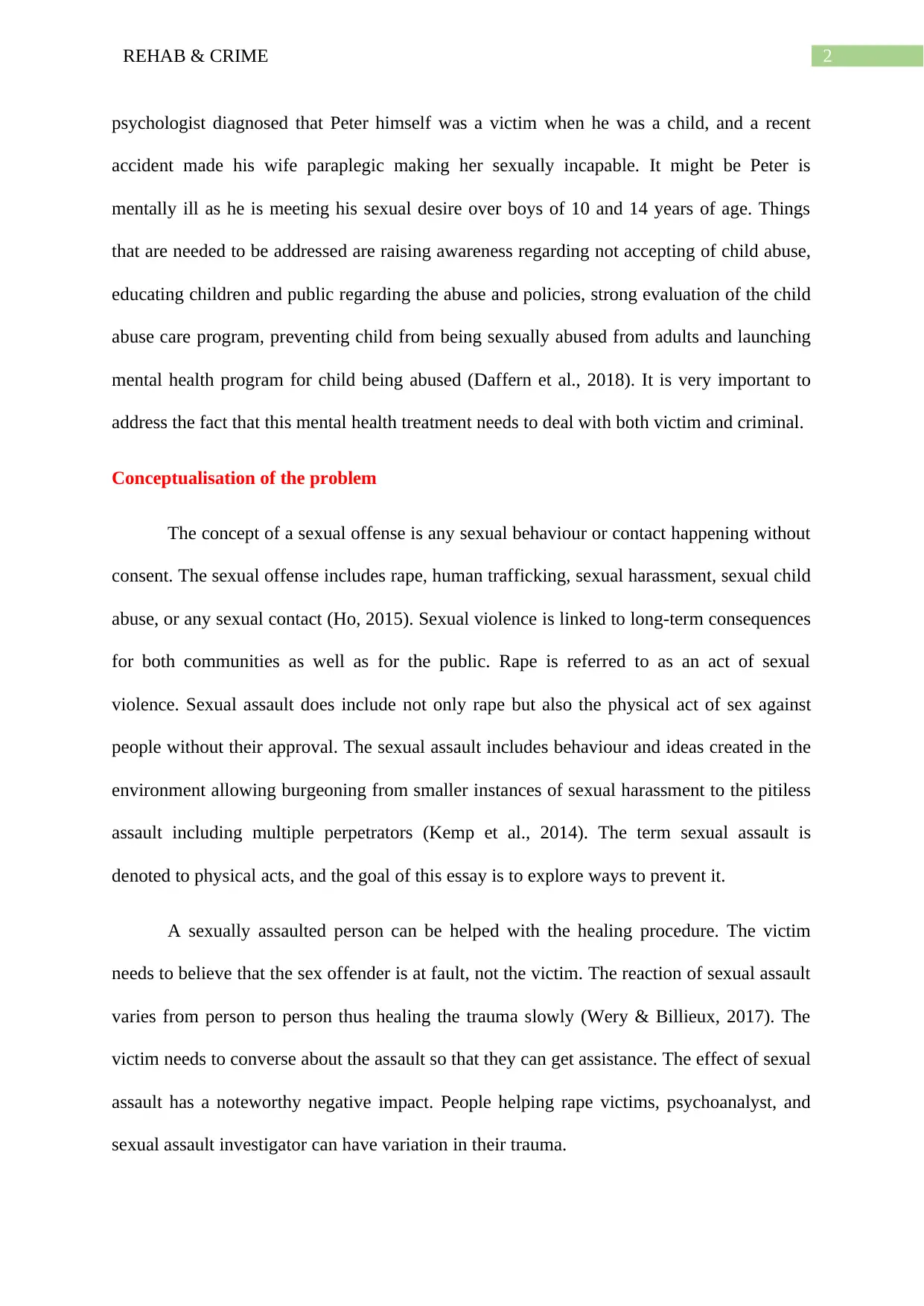
2REHAB & CRIME
psychologist diagnosed that Peter himself was a victim when he was a child, and a recent
accident made his wife paraplegic making her sexually incapable. It might be Peter is
mentally ill as he is meeting his sexual desire over boys of 10 and 14 years of age. Things
that are needed to be addressed are raising awareness regarding not accepting of child abuse,
educating children and public regarding the abuse and policies, strong evaluation of the child
abuse care program, preventing child from being sexually abused from adults and launching
mental health program for child being abused (Daffern et al., 2018). It is very important to
address the fact that this mental health treatment needs to deal with both victim and criminal.
Conceptualisation of the problem
The concept of a sexual offense is any sexual behaviour or contact happening without
consent. The sexual offense includes rape, human trafficking, sexual harassment, sexual child
abuse, or any sexual contact (Ho, 2015). Sexual violence is linked to long-term consequences
for both communities as well as for the public. Rape is referred to as an act of sexual
violence. Sexual assault does include not only rape but also the physical act of sex against
people without their approval. The sexual assault includes behaviour and ideas created in the
environment allowing burgeoning from smaller instances of sexual harassment to the pitiless
assault including multiple perpetrators (Kemp et al., 2014). The term sexual assault is
denoted to physical acts, and the goal of this essay is to explore ways to prevent it.
A sexually assaulted person can be helped with the healing procedure. The victim
needs to believe that the sex offender is at fault, not the victim. The reaction of sexual assault
varies from person to person thus healing the trauma slowly (Wery & Billieux, 2017). The
victim needs to converse about the assault so that they can get assistance. The effect of sexual
assault has a noteworthy negative impact. People helping rape victims, psychoanalyst, and
sexual assault investigator can have variation in their trauma.
psychologist diagnosed that Peter himself was a victim when he was a child, and a recent
accident made his wife paraplegic making her sexually incapable. It might be Peter is
mentally ill as he is meeting his sexual desire over boys of 10 and 14 years of age. Things
that are needed to be addressed are raising awareness regarding not accepting of child abuse,
educating children and public regarding the abuse and policies, strong evaluation of the child
abuse care program, preventing child from being sexually abused from adults and launching
mental health program for child being abused (Daffern et al., 2018). It is very important to
address the fact that this mental health treatment needs to deal with both victim and criminal.
Conceptualisation of the problem
The concept of a sexual offense is any sexual behaviour or contact happening without
consent. The sexual offense includes rape, human trafficking, sexual harassment, sexual child
abuse, or any sexual contact (Ho, 2015). Sexual violence is linked to long-term consequences
for both communities as well as for the public. Rape is referred to as an act of sexual
violence. Sexual assault does include not only rape but also the physical act of sex against
people without their approval. The sexual assault includes behaviour and ideas created in the
environment allowing burgeoning from smaller instances of sexual harassment to the pitiless
assault including multiple perpetrators (Kemp et al., 2014). The term sexual assault is
denoted to physical acts, and the goal of this essay is to explore ways to prevent it.
A sexually assaulted person can be helped with the healing procedure. The victim
needs to believe that the sex offender is at fault, not the victim. The reaction of sexual assault
varies from person to person thus healing the trauma slowly (Wery & Billieux, 2017). The
victim needs to converse about the assault so that they can get assistance. The effect of sexual
assault has a noteworthy negative impact. People helping rape victims, psychoanalyst, and
sexual assault investigator can have variation in their trauma.
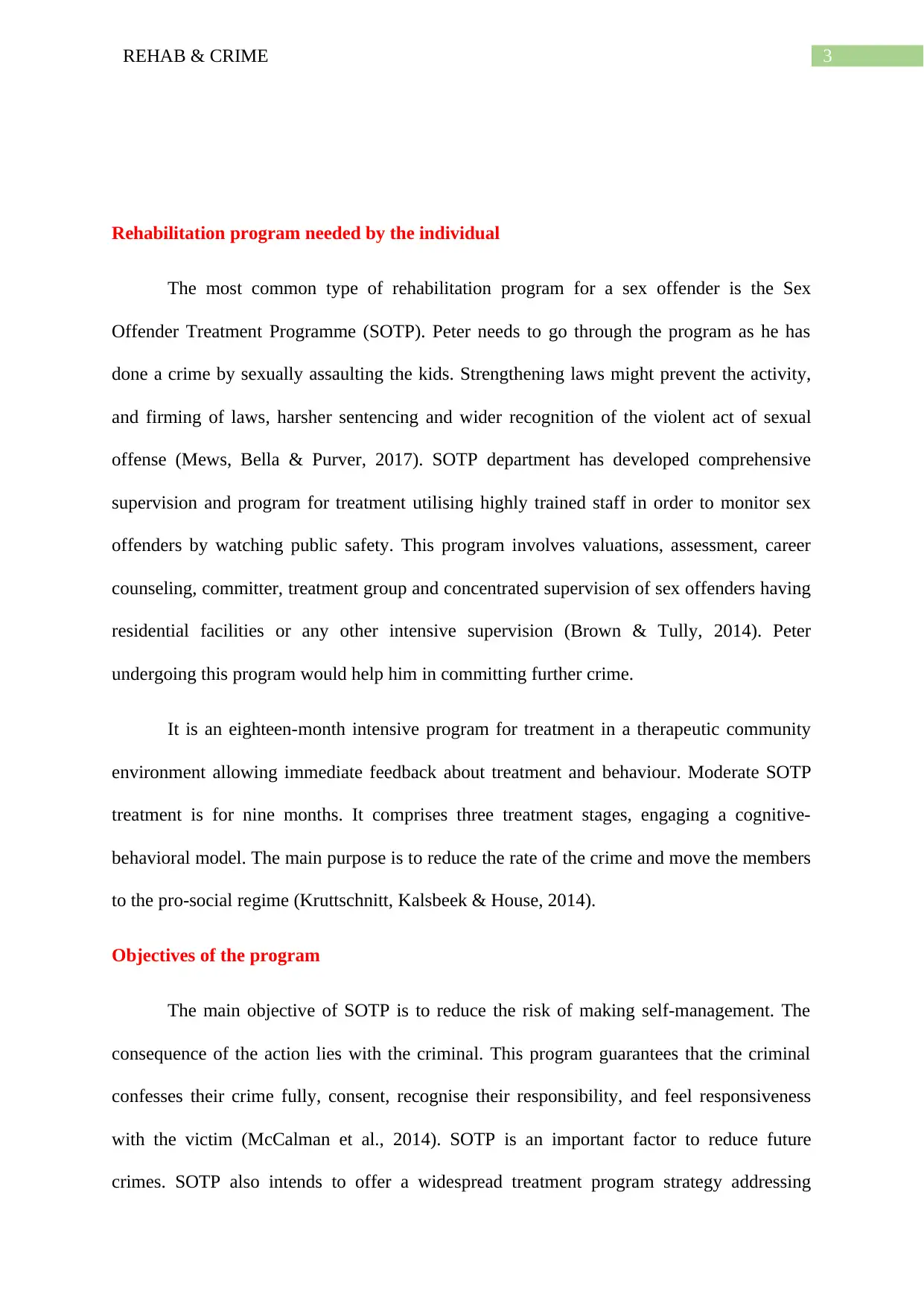
3REHAB & CRIME
Rehabilitation program needed by the individual
The most common type of rehabilitation program for a sex offender is the Sex
Offender Treatment Programme (SOTP). Peter needs to go through the program as he has
done a crime by sexually assaulting the kids. Strengthening laws might prevent the activity,
and firming of laws, harsher sentencing and wider recognition of the violent act of sexual
offense (Mews, Bella & Purver, 2017). SOTP department has developed comprehensive
supervision and program for treatment utilising highly trained staff in order to monitor sex
offenders by watching public safety. This program involves valuations, assessment, career
counseling, committer, treatment group and concentrated supervision of sex offenders having
residential facilities or any other intensive supervision (Brown & Tully, 2014). Peter
undergoing this program would help him in committing further crime.
It is an eighteen-month intensive program for treatment in a therapeutic community
environment allowing immediate feedback about treatment and behaviour. Moderate SOTP
treatment is for nine months. It comprises three treatment stages, engaging a cognitive-
behavioral model. The main purpose is to reduce the rate of the crime and move the members
to the pro-social regime (Kruttschnitt, Kalsbeek & House, 2014).
Objectives of the program
The main objective of SOTP is to reduce the risk of making self-management. The
consequence of the action lies with the criminal. This program guarantees that the criminal
confesses their crime fully, consent, recognise their responsibility, and feel responsiveness
with the victim (McCalman et al., 2014). SOTP is an important factor to reduce future
crimes. SOTP also intends to offer a widespread treatment program strategy addressing
Rehabilitation program needed by the individual
The most common type of rehabilitation program for a sex offender is the Sex
Offender Treatment Programme (SOTP). Peter needs to go through the program as he has
done a crime by sexually assaulting the kids. Strengthening laws might prevent the activity,
and firming of laws, harsher sentencing and wider recognition of the violent act of sexual
offense (Mews, Bella & Purver, 2017). SOTP department has developed comprehensive
supervision and program for treatment utilising highly trained staff in order to monitor sex
offenders by watching public safety. This program involves valuations, assessment, career
counseling, committer, treatment group and concentrated supervision of sex offenders having
residential facilities or any other intensive supervision (Brown & Tully, 2014). Peter
undergoing this program would help him in committing further crime.
It is an eighteen-month intensive program for treatment in a therapeutic community
environment allowing immediate feedback about treatment and behaviour. Moderate SOTP
treatment is for nine months. It comprises three treatment stages, engaging a cognitive-
behavioral model. The main purpose is to reduce the rate of the crime and move the members
to the pro-social regime (Kruttschnitt, Kalsbeek & House, 2014).
Objectives of the program
The main objective of SOTP is to reduce the risk of making self-management. The
consequence of the action lies with the criminal. This program guarantees that the criminal
confesses their crime fully, consent, recognise their responsibility, and feel responsiveness
with the victim (McCalman et al., 2014). SOTP is an important factor to reduce future
crimes. SOTP also intends to offer a widespread treatment program strategy addressing
Secure Best Marks with AI Grader
Need help grading? Try our AI Grader for instant feedback on your assignments.
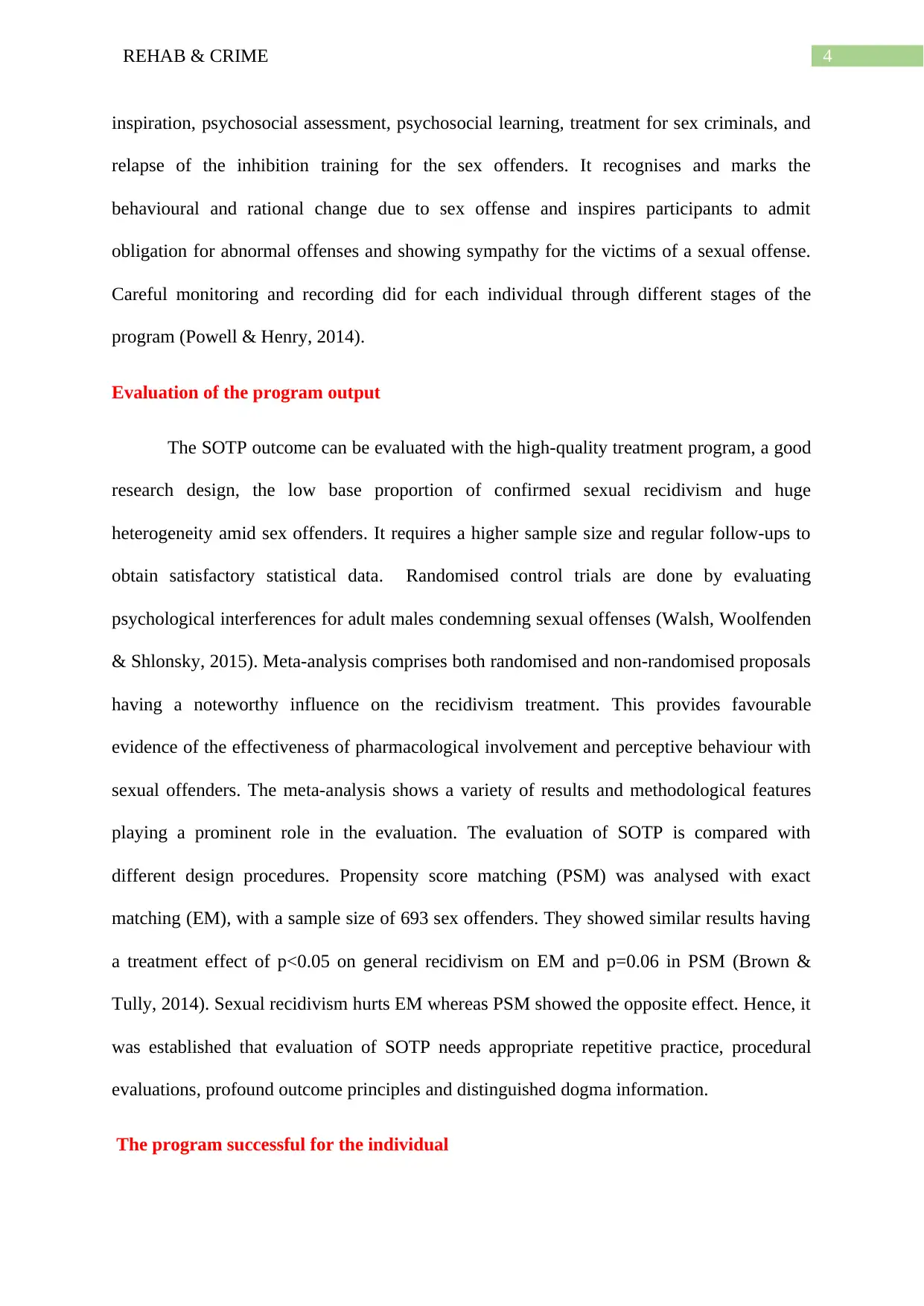
4REHAB & CRIME
inspiration, psychosocial assessment, psychosocial learning, treatment for sex criminals, and
relapse of the inhibition training for the sex offenders. It recognises and marks the
behavioural and rational change due to sex offense and inspires participants to admit
obligation for abnormal offenses and showing sympathy for the victims of a sexual offense.
Careful monitoring and recording did for each individual through different stages of the
program (Powell & Henry, 2014).
Evaluation of the program output
The SOTP outcome can be evaluated with the high-quality treatment program, a good
research design, the low base proportion of confirmed sexual recidivism and huge
heterogeneity amid sex offenders. It requires a higher sample size and regular follow-ups to
obtain satisfactory statistical data. Randomised control trials are done by evaluating
psychological interferences for adult males condemning sexual offenses (Walsh, Woolfenden
& Shlonsky, 2015). Meta-analysis comprises both randomised and non-randomised proposals
having a noteworthy influence on the recidivism treatment. This provides favourable
evidence of the effectiveness of pharmacological involvement and perceptive behaviour with
sexual offenders. The meta-analysis shows a variety of results and methodological features
playing a prominent role in the evaluation. The evaluation of SOTP is compared with
different design procedures. Propensity score matching (PSM) was analysed with exact
matching (EM), with a sample size of 693 sex offenders. They showed similar results having
a treatment effect of p<0.05 on general recidivism on EM and p=0.06 in PSM (Brown &
Tully, 2014). Sexual recidivism hurts EM whereas PSM showed the opposite effect. Hence, it
was established that evaluation of SOTP needs appropriate repetitive practice, procedural
evaluations, profound outcome principles and distinguished dogma information.
The program successful for the individual
inspiration, psychosocial assessment, psychosocial learning, treatment for sex criminals, and
relapse of the inhibition training for the sex offenders. It recognises and marks the
behavioural and rational change due to sex offense and inspires participants to admit
obligation for abnormal offenses and showing sympathy for the victims of a sexual offense.
Careful monitoring and recording did for each individual through different stages of the
program (Powell & Henry, 2014).
Evaluation of the program output
The SOTP outcome can be evaluated with the high-quality treatment program, a good
research design, the low base proportion of confirmed sexual recidivism and huge
heterogeneity amid sex offenders. It requires a higher sample size and regular follow-ups to
obtain satisfactory statistical data. Randomised control trials are done by evaluating
psychological interferences for adult males condemning sexual offenses (Walsh, Woolfenden
& Shlonsky, 2015). Meta-analysis comprises both randomised and non-randomised proposals
having a noteworthy influence on the recidivism treatment. This provides favourable
evidence of the effectiveness of pharmacological involvement and perceptive behaviour with
sexual offenders. The meta-analysis shows a variety of results and methodological features
playing a prominent role in the evaluation. The evaluation of SOTP is compared with
different design procedures. Propensity score matching (PSM) was analysed with exact
matching (EM), with a sample size of 693 sex offenders. They showed similar results having
a treatment effect of p<0.05 on general recidivism on EM and p=0.06 in PSM (Brown &
Tully, 2014). Sexual recidivism hurts EM whereas PSM showed the opposite effect. Hence, it
was established that evaluation of SOTP needs appropriate repetitive practice, procedural
evaluations, profound outcome principles and distinguished dogma information.
The program successful for the individual
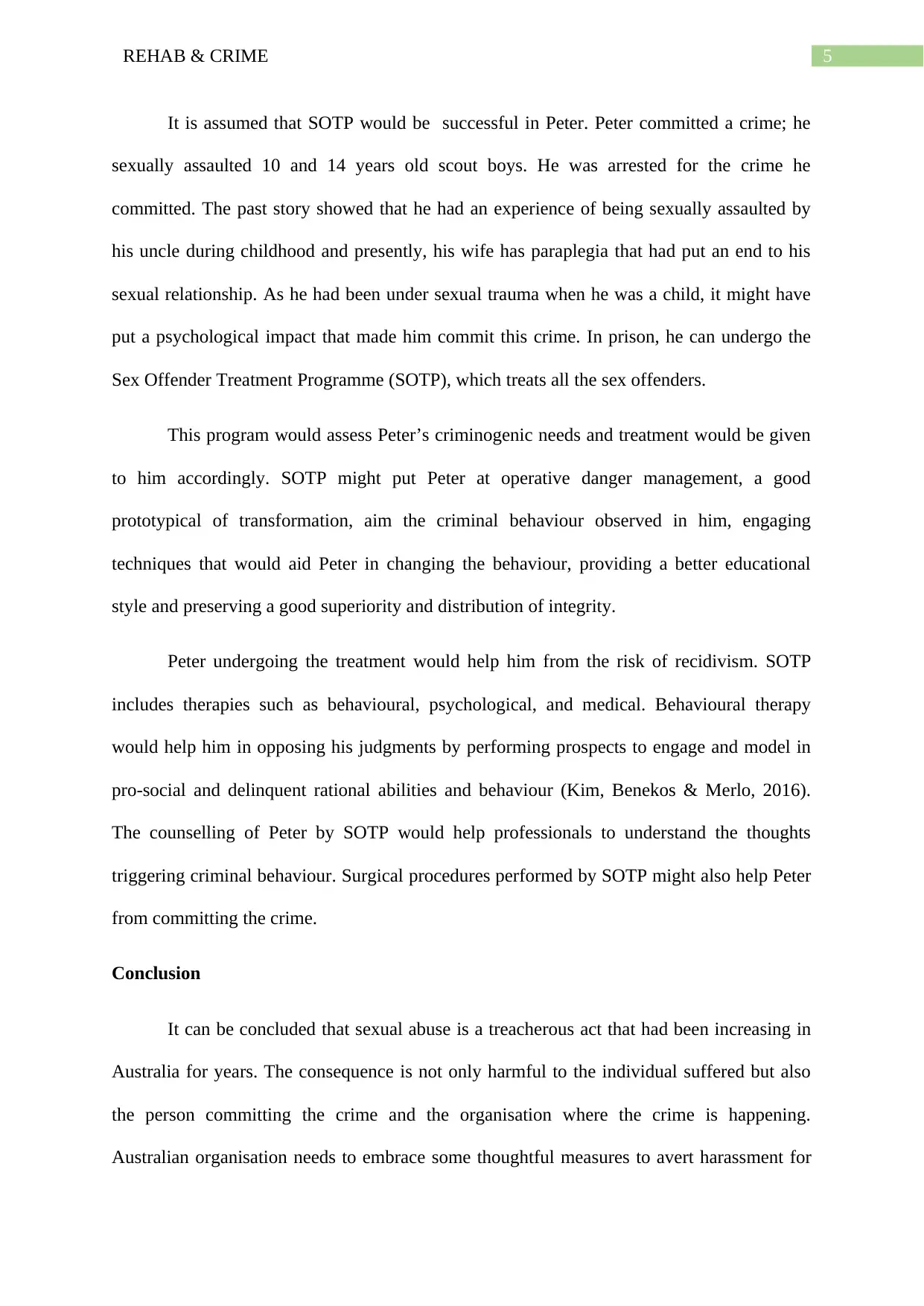
5REHAB & CRIME
It is assumed that SOTP would be successful in Peter. Peter committed a crime; he
sexually assaulted 10 and 14 years old scout boys. He was arrested for the crime he
committed. The past story showed that he had an experience of being sexually assaulted by
his uncle during childhood and presently, his wife has paraplegia that had put an end to his
sexual relationship. As he had been under sexual trauma when he was a child, it might have
put a psychological impact that made him commit this crime. In prison, he can undergo the
Sex Offender Treatment Programme (SOTP), which treats all the sex offenders.
This program would assess Peter’s criminogenic needs and treatment would be given
to him accordingly. SOTP might put Peter at operative danger management, a good
prototypical of transformation, aim the criminal behaviour observed in him, engaging
techniques that would aid Peter in changing the behaviour, providing a better educational
style and preserving a good superiority and distribution of integrity.
Peter undergoing the treatment would help him from the risk of recidivism. SOTP
includes therapies such as behavioural, psychological, and medical. Behavioural therapy
would help him in opposing his judgments by performing prospects to engage and model in
pro-social and delinquent rational abilities and behaviour (Kim, Benekos & Merlo, 2016).
The counselling of Peter by SOTP would help professionals to understand the thoughts
triggering criminal behaviour. Surgical procedures performed by SOTP might also help Peter
from committing the crime.
Conclusion
It can be concluded that sexual abuse is a treacherous act that had been increasing in
Australia for years. The consequence is not only harmful to the individual suffered but also
the person committing the crime and the organisation where the crime is happening.
Australian organisation needs to embrace some thoughtful measures to avert harassment for
It is assumed that SOTP would be successful in Peter. Peter committed a crime; he
sexually assaulted 10 and 14 years old scout boys. He was arrested for the crime he
committed. The past story showed that he had an experience of being sexually assaulted by
his uncle during childhood and presently, his wife has paraplegia that had put an end to his
sexual relationship. As he had been under sexual trauma when he was a child, it might have
put a psychological impact that made him commit this crime. In prison, he can undergo the
Sex Offender Treatment Programme (SOTP), which treats all the sex offenders.
This program would assess Peter’s criminogenic needs and treatment would be given
to him accordingly. SOTP might put Peter at operative danger management, a good
prototypical of transformation, aim the criminal behaviour observed in him, engaging
techniques that would aid Peter in changing the behaviour, providing a better educational
style and preserving a good superiority and distribution of integrity.
Peter undergoing the treatment would help him from the risk of recidivism. SOTP
includes therapies such as behavioural, psychological, and medical. Behavioural therapy
would help him in opposing his judgments by performing prospects to engage and model in
pro-social and delinquent rational abilities and behaviour (Kim, Benekos & Merlo, 2016).
The counselling of Peter by SOTP would help professionals to understand the thoughts
triggering criminal behaviour. Surgical procedures performed by SOTP might also help Peter
from committing the crime.
Conclusion
It can be concluded that sexual abuse is a treacherous act that had been increasing in
Australia for years. The consequence is not only harmful to the individual suffered but also
the person committing the crime and the organisation where the crime is happening.
Australian organisation needs to embrace some thoughtful measures to avert harassment for
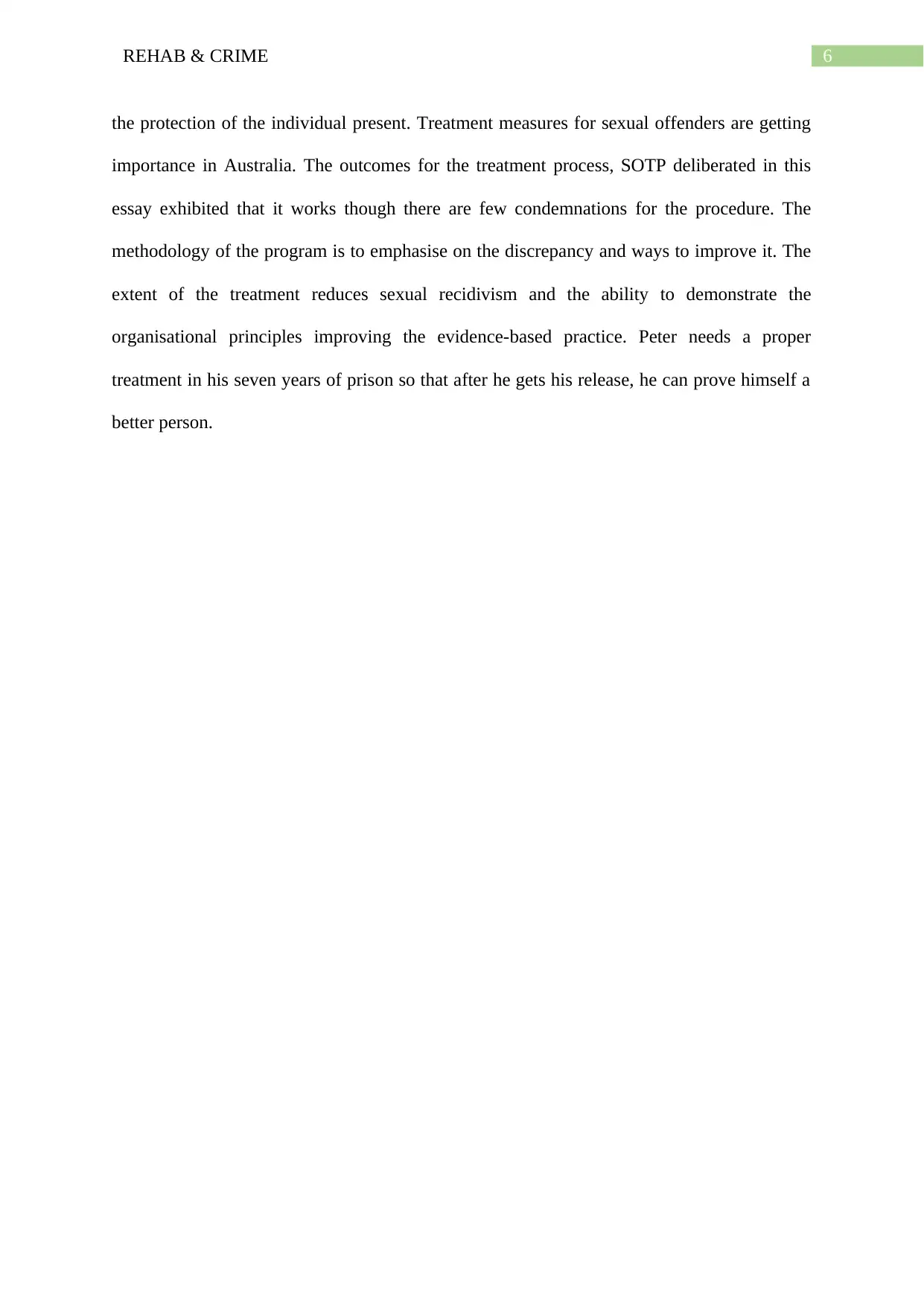
6REHAB & CRIME
the protection of the individual present. Treatment measures for sexual offenders are getting
importance in Australia. The outcomes for the treatment process, SOTP deliberated in this
essay exhibited that it works though there are few condemnations for the procedure. The
methodology of the program is to emphasise on the discrepancy and ways to improve it. The
extent of the treatment reduces sexual recidivism and the ability to demonstrate the
organisational principles improving the evidence-based practice. Peter needs a proper
treatment in his seven years of prison so that after he gets his release, he can prove himself a
better person.
the protection of the individual present. Treatment measures for sexual offenders are getting
importance in Australia. The outcomes for the treatment process, SOTP deliberated in this
essay exhibited that it works though there are few condemnations for the procedure. The
methodology of the program is to emphasise on the discrepancy and ways to improve it. The
extent of the treatment reduces sexual recidivism and the ability to demonstrate the
organisational principles improving the evidence-based practice. Peter needs a proper
treatment in his seven years of prison so that after he gets his release, he can prove himself a
better person.
Paraphrase This Document
Need a fresh take? Get an instant paraphrase of this document with our AI Paraphraser
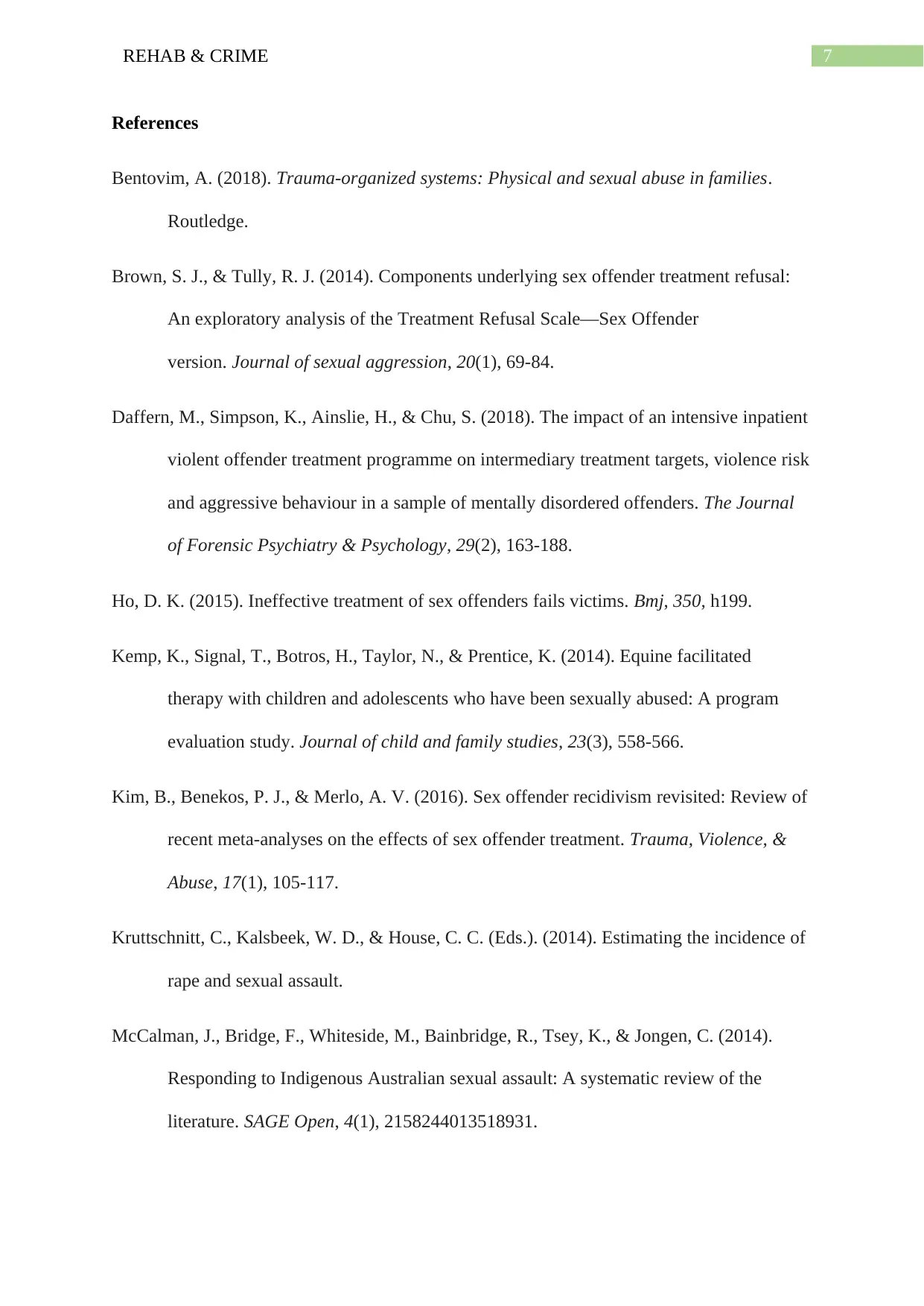
7REHAB & CRIME
References
Bentovim, A. (2018). Trauma-organized systems: Physical and sexual abuse in families.
Routledge.
Brown, S. J., & Tully, R. J. (2014). Components underlying sex offender treatment refusal:
An exploratory analysis of the Treatment Refusal Scale—Sex Offender
version. Journal of sexual aggression, 20(1), 69-84.
Daffern, M., Simpson, K., Ainslie, H., & Chu, S. (2018). The impact of an intensive inpatient
violent offender treatment programme on intermediary treatment targets, violence risk
and aggressive behaviour in a sample of mentally disordered offenders. The Journal
of Forensic Psychiatry & Psychology, 29(2), 163-188.
Ho, D. K. (2015). Ineffective treatment of sex offenders fails victims. Bmj, 350, h199.
Kemp, K., Signal, T., Botros, H., Taylor, N., & Prentice, K. (2014). Equine facilitated
therapy with children and adolescents who have been sexually abused: A program
evaluation study. Journal of child and family studies, 23(3), 558-566.
Kim, B., Benekos, P. J., & Merlo, A. V. (2016). Sex offender recidivism revisited: Review of
recent meta-analyses on the effects of sex offender treatment. Trauma, Violence, &
Abuse, 17(1), 105-117.
Kruttschnitt, C., Kalsbeek, W. D., & House, C. C. (Eds.). (2014). Estimating the incidence of
rape and sexual assault.
McCalman, J., Bridge, F., Whiteside, M., Bainbridge, R., Tsey, K., & Jongen, C. (2014).
Responding to Indigenous Australian sexual assault: A systematic review of the
literature. SAGE Open, 4(1), 2158244013518931.
References
Bentovim, A. (2018). Trauma-organized systems: Physical and sexual abuse in families.
Routledge.
Brown, S. J., & Tully, R. J. (2014). Components underlying sex offender treatment refusal:
An exploratory analysis of the Treatment Refusal Scale—Sex Offender
version. Journal of sexual aggression, 20(1), 69-84.
Daffern, M., Simpson, K., Ainslie, H., & Chu, S. (2018). The impact of an intensive inpatient
violent offender treatment programme on intermediary treatment targets, violence risk
and aggressive behaviour in a sample of mentally disordered offenders. The Journal
of Forensic Psychiatry & Psychology, 29(2), 163-188.
Ho, D. K. (2015). Ineffective treatment of sex offenders fails victims. Bmj, 350, h199.
Kemp, K., Signal, T., Botros, H., Taylor, N., & Prentice, K. (2014). Equine facilitated
therapy with children and adolescents who have been sexually abused: A program
evaluation study. Journal of child and family studies, 23(3), 558-566.
Kim, B., Benekos, P. J., & Merlo, A. V. (2016). Sex offender recidivism revisited: Review of
recent meta-analyses on the effects of sex offender treatment. Trauma, Violence, &
Abuse, 17(1), 105-117.
Kruttschnitt, C., Kalsbeek, W. D., & House, C. C. (Eds.). (2014). Estimating the incidence of
rape and sexual assault.
McCalman, J., Bridge, F., Whiteside, M., Bainbridge, R., Tsey, K., & Jongen, C. (2014).
Responding to Indigenous Australian sexual assault: A systematic review of the
literature. SAGE Open, 4(1), 2158244013518931.
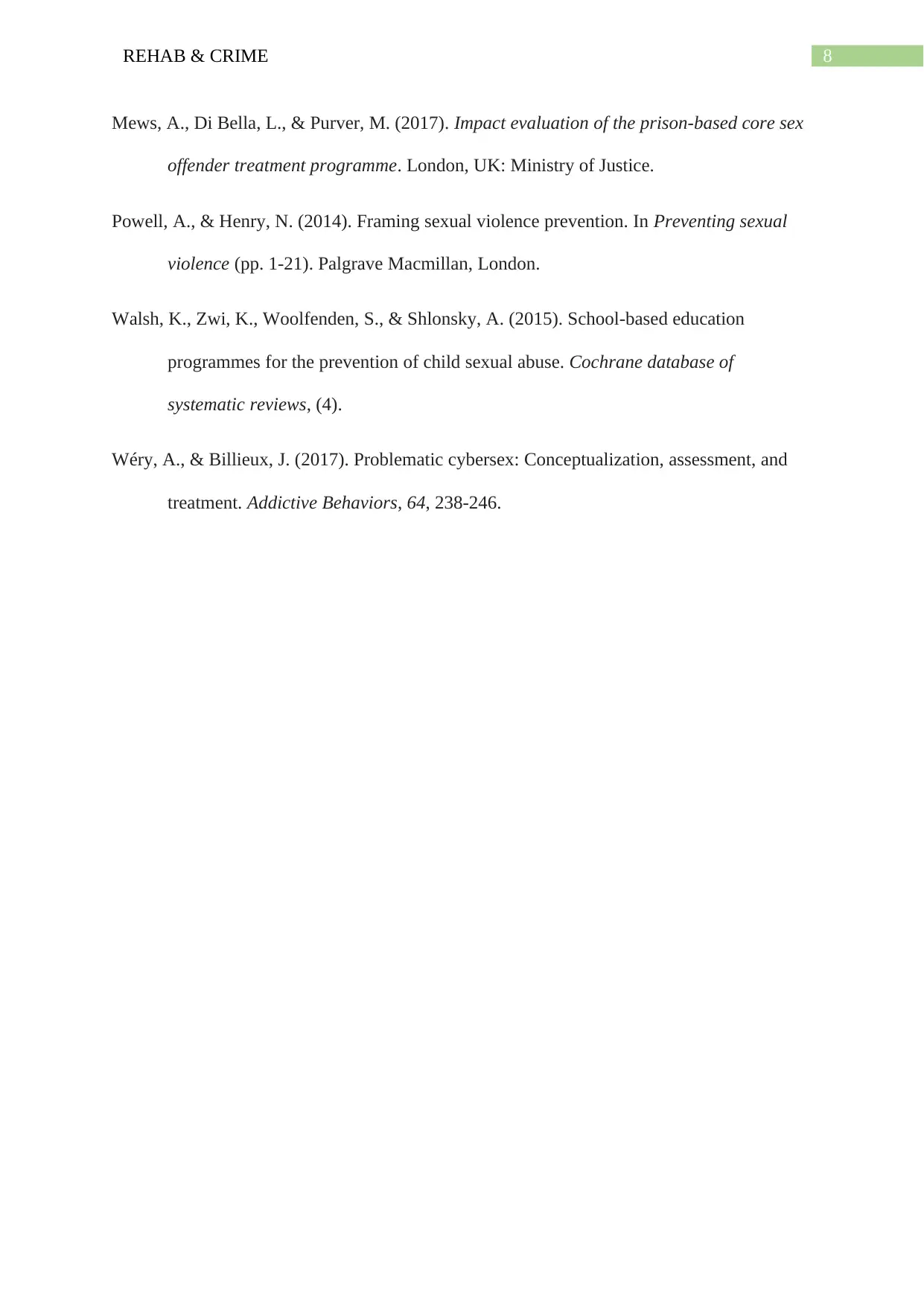
8REHAB & CRIME
Mews, A., Di Bella, L., & Purver, M. (2017). Impact evaluation of the prison-based core sex
offender treatment programme. London, UK: Ministry of Justice.
Powell, A., & Henry, N. (2014). Framing sexual violence prevention. In Preventing sexual
violence (pp. 1-21). Palgrave Macmillan, London.
Walsh, K., Zwi, K., Woolfenden, S., & Shlonsky, A. (2015). School‐based education
programmes for the prevention of child sexual abuse. Cochrane database of
systematic reviews, (4).
Wéry, A., & Billieux, J. (2017). Problematic cybersex: Conceptualization, assessment, and
treatment. Addictive Behaviors, 64, 238-246.
Mews, A., Di Bella, L., & Purver, M. (2017). Impact evaluation of the prison-based core sex
offender treatment programme. London, UK: Ministry of Justice.
Powell, A., & Henry, N. (2014). Framing sexual violence prevention. In Preventing sexual
violence (pp. 1-21). Palgrave Macmillan, London.
Walsh, K., Zwi, K., Woolfenden, S., & Shlonsky, A. (2015). School‐based education
programmes for the prevention of child sexual abuse. Cochrane database of
systematic reviews, (4).
Wéry, A., & Billieux, J. (2017). Problematic cybersex: Conceptualization, assessment, and
treatment. Addictive Behaviors, 64, 238-246.
1 out of 9
Related Documents
Your All-in-One AI-Powered Toolkit for Academic Success.
+13062052269
info@desklib.com
Available 24*7 on WhatsApp / Email
![[object Object]](/_next/static/media/star-bottom.7253800d.svg)
Unlock your academic potential
© 2024 | Zucol Services PVT LTD | All rights reserved.




